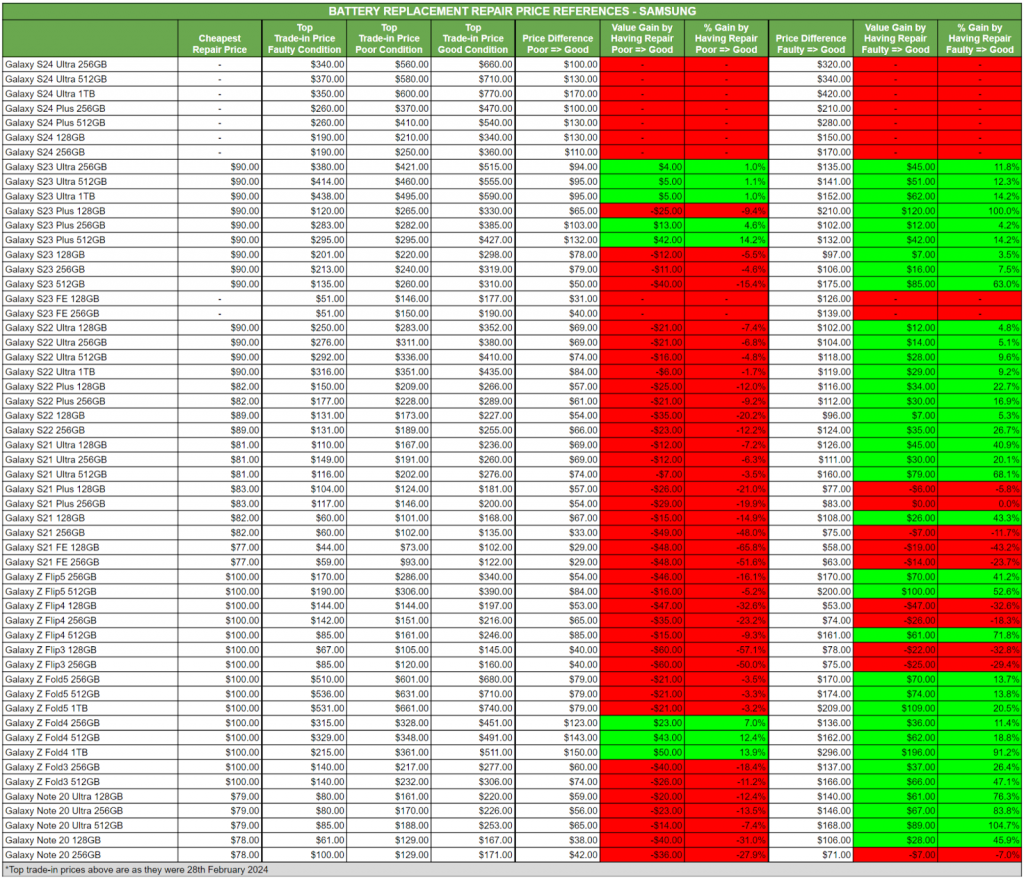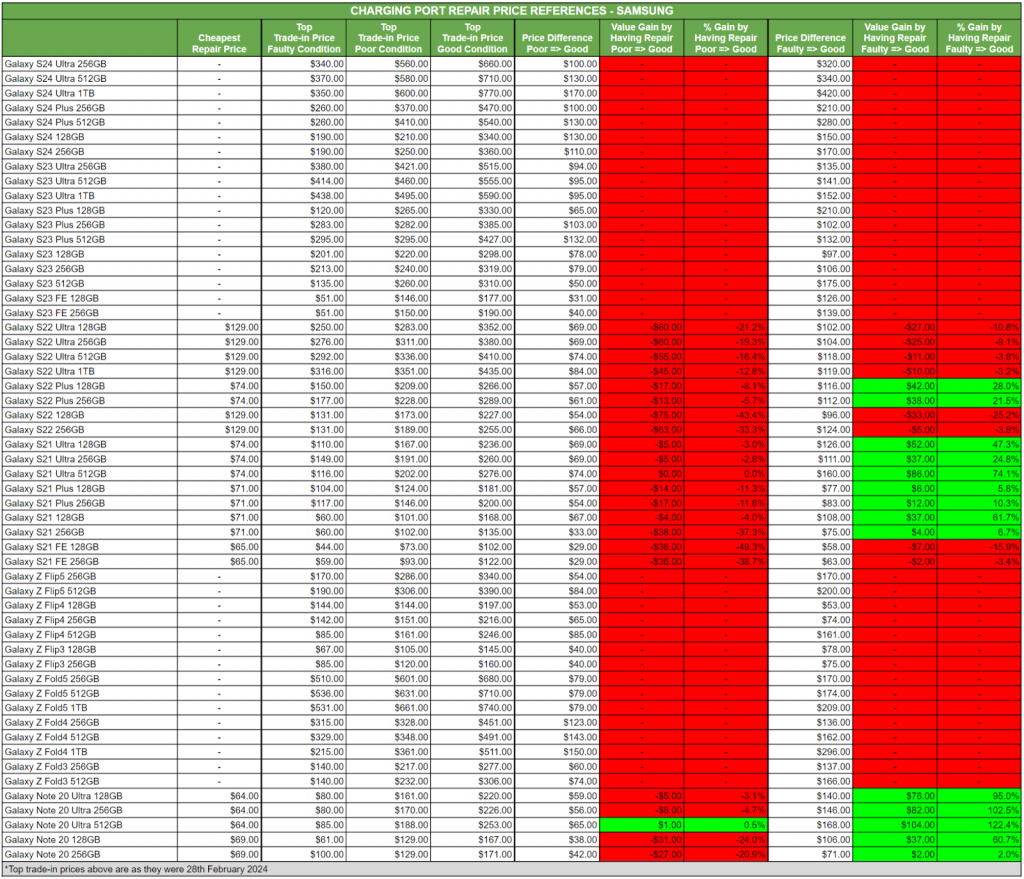Repairing your phone prior to trading in could actually mean you end up $308 out of pocket!
– Higher value repairs, like screen repairs, mean phone owners could be out of pocket by up to $308 if they repair before they sell.
– Smaller repairs make a sensible investment for phone owners, offering a return on investment when they trade in, potentially making users up to $233!
– Apple’s iPhone 15 Pro 512GB offers the best return on a repair investment, for multiple repair types.
Report Objective: Should I Repair My Phone Before I Trade In?
If you have a broken phone, you may well think to yourself, “should I repair my phone before I sell it?” When trading in a broken phone, its value significantly decreases compared to one in good condition. The price difference between faulty and functional phones can be substantial, sometimes amounting to hundreds of dollars. Given the high cost of new flagship phones, maximizing the resale value of your old phone is crucial.
Statista’s report 1 states globally, 408 million people own a mobile phone insurance policy, which accounts for only 6% of the 6.8 billion mobile phone owners worldwide. This means that 94% of individuals do not possess any form of phone warranty, care package, or insurance.
Consequently, if their phone malfunctions, they will probably incur a one-off repair cost. Given that most people upgrade their phones every 3.6 years, investing in a care package might seem costly over such a period if the phone owner seldom needs repairs. This report will assess whether one-off repair prices are worthwhile investments during upgrades and if they yield additional trade-in value.
What Will This Report Look At?
This report will assess whether repairing a phone before selling it is financially viable. SellCell conducted comprehensive research across the repair industry, including major players like Apple, Best Buy, CPR, GadgetMates, Samsung, and others.
By comparing repair costs with trade-in values, SellCell aims to determine whether repairs yield higher profits or if selling the phone in its faulty condition is more financially beneficial. Let’s review the findings.
Key Highlights

- An iPhone 15 Pro 512GB offers the best cash gain. By repairing the battery in a “faulty” phone so it would be reclassified as “good condition”, consumers receive a $233.00 gain on “faulty” value at trade-in.
- A Galaxy ZFold 4 256GB offers the worst cash gain. By repairing the screen, owners can LOSE $308.00 repairing from “faulty” condition up to “good” (no surprise, as the screens are foldable and prone to significant wear).
- The average profit after repair for a smartphone screen repair across Apple, Samsung, and Google handsets is -$95.68. Those repairing a screen before trade-in are therefore losing money by repairing.
- For all Apple, Samsung and Google handsets, the average profit after repairing rear glass is -$0.68. Thus, repairing a rear face prior to trade-in is a waste of money.
- For profit after repairing a rear camera, across all Apple, Samsung, and Google handsets, on average those trading in will gain $17.64. So, it probably isn’t really worth the hassle of repairing the rear camera if you trade in.
- In general, larger repairs such as screen replacement are not worth carrying out prior to trade-in. They may increase the value of your phone, but they cost the most, so can leave consumers out of pocket.
- Some smaller repairs, such as battery replacement, can turn a profit for consumers, making them worthwhile. However, consumers should weigh up the cost of the repair versus the value gained in order to see if it will prove profitable.
How to Determine What Condition Your Phone Is In
The condition of your phone will decide how much cash you get when you trade it in. It is important to know how to classify your phone’s condition prior to trade-in, so you can determine what you’ll get back accurately. As SellCell’s “How Much Is My Phone Worth?” page states:
‘Mint’ Condition:
- Device must appear brand new, showing no signs of prior use.
- Flawless condition without any scratches or cosmetic flaws.
- Functions at 100% capacity.
- Offers the highest resale value among pre-owned phones.
‘Good’ Condition:
- Displays light to moderate wear or scratches indicative of normal usage.
- Functions at 100% capacity despite minor blemishes.
- Represents the most common condition for devices (80% or more).
- Typically experiences a 5-10% loss in value compared to ‘Like New’ phones.
‘Poor’ Condition:
- Exhibits heavy wear such as excessive scratches or dents.
- Fully functional despite noticeable cosmetic flaws.
- Typically loses 20% of its original value compared to ‘Like New’ phones.
‘Faulty’ Condition:
- Shows significant damage or functional issues (e.g., smashed screen, faulty components).
- Experiences a substantial depreciation, losing between 40-60% of its original value compared to ‘Like New’ phones.
Looking at the information above, particularly comparing value loss against a “mint” phone, we can see why people would assume it is a good idea to repair before they sell, in order to increase profit at trade-in.
Main Findings: Should You Repair Your Smartphone Prior to Trade-In?
In the following sections, we will look at individual brands, taking into account various types of repair to see if it is profitable to repair before trade-in, or whether it will result in a loss. We have also started the section by looking at the smartphone repair market in general.
NB: No reliable repair data exists for any of Google’s Pixel handsets, aside from the Google Pixel 5 128GB. As a result, this data has been omitted from the main findings, below. Given the rapid value depreciation of Google’s handsets mere weeks after release (up to 62% depreciation in three months), it is unlikely that repairing a Google handset is ever going to yield a profit.
Average Repairs Across Brands

- Looking at repairs in a more general sense, across the mobile phone market, we can see the trend that we will see repeated throughout the rest of the data.
- Small repairs are worth the hassle, and can net you a tidy profit. Larger repairs can leave you out of pocket by, on average, $95.68. However, some repairs can leave you significantly out of pocket, as the data that follows shows.
Apple Screen Repair

- As the data above shows, in almost EVERY case, it is not worth repairing your screen before trade-in if you are an Apple owner.
- The only iPhone to turn a post-repair profit is the 15 Pro 512GB. Even then, repairing from “faulty” to “good” would only glean $3.00. So, you would need to ask yourself if that $3.00 is even worth the time spent packing the phone for repair.
- Repairing the screen on an iPhone 14 Pro Max 256GB, from “faulty” to “good” condition, would mean losing $236.00, or -47.2% of the profit. Your phone would effectively be worth less after repair, because you paid $379.00 for the cheapest repair—$236.00 more than the value gain of $143.00 that repairing the phone would generate.
These prices represent the most competitive rates available for Apple screen replacements within the repair market. Omitted from our analysis are the prices associated with the Apple Care Program, as its value is contingent upon individual usage patterns and timing of repairs. It is worth noting that the typical upgrade cycle for phones is around 3.6 years. By this juncture, an Apple Care package would have incurred a cost of around $377.00. However, notwithstanding this expenditure, such coverage can prove exceedingly beneficial and cost-effective should an unforeseen damage occur early in the ownership cycle of the device.

A mere 4% of individuals opt for the security of an Apple Care Package upfront 2. The majority prefer to adopt a wait-and-see approach, evaluating whether their phone undergoes damage, relying on alternative insurance options, opting for pay-as-you-go repairs, or even resorting to selling their faulty phones. This cautious behavior reflects a widespread tendency to weigh the cost-benefit analysis before committing to such protection plans.
Samsung Screen Repair

- Samsung performs a little better for value gain when it comes to repairing its smartphone screens from “faulty” to “good” prior to trade in.
- The Galaxy S24 Ultra 1TB performs best. The cheapest cost of screen repair is $259.00. The price difference between a “faulty” and a “good” condition phone is $420.00. Therefore the profit you make will be $161.00, or 46.0%.
- Repairing the folding screen on a ZFold 4 256Gb will cause you to lose $308.00, because the cheapest screen repair is $444.00 and the price difference between “faulty” and “good” is only $136.
Apple Rear Glass Repair

- The rear glass of an Apple phone is just as likely to smash as the front screen. However, replacement is cheaper because the glass face has no functional uses in the way a screen does.
- As we can see, this smaller repair yields a profit with several models. Again, the iPhone 15 Pro 512GB is bringing in the most profit post-repair, with $163.00 gain.
- If you own an iPhone 14 Pro Max 256GB, then repairing really isn’t in your best interests. You will lose $75.00 if you pay to repair this model’s rear glass prior to trading in.
Samsung Rear Glass Repair

- There isn’t a lot of reliable repair data for Samsung rear glass, although repair companies will fix the glass on some models.
- None of the models we have data for are really worth repairing as they only yield a profit between $4.00 (Galaxy S22 Plus 256GB) and $9.00 (S21 Ultra 512GB).
- The Galaxy Note 20 yields the worst results, leaving you $86.00 out of pocket if you repair prior to trading the handset in.
Apple Battery Repair

- As the table illustrates, when we get to minor repairs or replacements such as batteries, there is certainly a justifiable reason to carry the repair out prior to trade in—for the majority of handsets, anyway.
- You guessed it; again the iPhone 15 Pro 512GB delivers the best return when you replace its battery prior to selling the device, gaining $233.00 post-repair.
- The 2020 iPhone SE 2nd Gen 64GB will lose you $27.00, so there is no point repairing before you trade the device in.
Samsung Battery Repair

- Samsung follows suit, making the case that smaller repairs are likely to lead to more profitable returns when trading a device in. Note that no reliable data exists for the latest generation of Galaxy S-Series handsets.
- The Galaxy ZFold 4 1TB benefits the most from a battery replacement. Getting it from “faulty” to “good” condition yields additional profit of $196.00.
- Don’t bother replacing the battery in a ZFlip 4 128GB, though. You’ll lose $47 dollars if you pay to repair this element before you trade your smartphone in.
Apple Charging Port Repair

- When repairing a smartphone from “faulty” to “good” condition, the data above shows that, in most cases, a repair will yield a profit for the owner.
- As with the other repairs above, the iPhone 15 Pro 512GB delivers the best gain, with an additional $183.00 added to the value of the phone post-repair.
- The iPhone SE 2nd Gen (2020) 64GB will lose the owner $42.00. However, the phone is four years old at this point, and so the trade-in value is pretty low in the first place, even for a phone in “good” condition, which is only worth $52.00.
Samsung Charging Port Repair

- Again, the data for Samsung charging port repairs is fairly limited and doesn’t cover all models.
- The device that offers the best gain in value post-repair is the Note 20 Ultra 512GB model. Repairing this handset will result in the owner gaining $104.00 when the time comes to trade in.
- The Galaxy S22 128GB is the worst performer. Repairing the charging port on this device will result in the owner losing $33.00.
Apple Rear Camera Repair

- With Apple devices, a rear camera repair is favorable in the majority of cases where it promotes a handset from “faulty” to “good” condition.
- The 512GB iPhone 15 Pro and Plus models are level pegging on value gained after repairing the rear camera. Both gain a healthy $113.
- The worst performer here is the iPhone SE 2nd Gen (2020) 64GB. Replacing its battery will lose you $49.00 once the cost of repair is taken into account.
Samsung Rear Camera Repair

- As with the other Samsung repairs above, reliable data for rear camera repairs is limited.
- In some cases, it is worth repairing your handset before you trade it in. These cases being the Galaxy Note 20 Ultra 512GB ($73.00 value gain) and S21 Ultra 512GB ($62.00 value gain).
- The Galaxy S21 256GB is the worst performer here, as it will generate a loss of $20.00 if you repair the rear camera before you decide to sell it on.
Most Profitable Repairs

- For easy reference, the above table shows the top 20 repairs that add the most value when you sell you phone. If you are thinking “should I repair my phone before I sell it?” then the above data will tell you. If your phone model and repair type is listed here, then you’re set to make a tidy profit if you repair before you sell.
How Many People Damage Their Phones?
According to a Gitnux market report 3, 66% of American phone owners have a damaged phone. Of all damaged phones, 30% have a damaged screen. This means that 30% of people with smartphones are unlikely to turn a profit if they fix the screen and then trade in.
Given that most phone damage is screen related 4 (29% is a cracked screen, 27% is a scratched screen), we can say that the likelihood is it won’t be worth repairing the majority of handsets before engaging in a trade-in with the expectation of earning greater returns, it’s essential to consider your options. Undoubtedly, the repair industry serves as a valuable commodity for smartphone owners, particularly for individuals bound by contractual obligations who then face unexpected accidents with their device. 22% of smartphone damage involves a non-working battery, which the data shown above illustrates is a good candidate for repairing and then gaining value when you trade your smartphone in post-repair.
Is Repairing Your Phone Pre-Trade-In Worth It?
Repairing a phone can prove to be a prudent decision at various points in its life cycle. In the unfortunate event that damage occurs early on—particularly during the initial stages of a contract—swift repair may be warranted. Leaving a broken phone unattended not only risks exacerbating the damage, such as through smartphone liquid ingress, but also poses potential inconveniences throughout the contract period.
Our research underscores the financial benefits of addressing smaller repairs, such as battery replacement or charging port repair. Repairing your phone in such instances can enhance its resale value, providing you with additional cash or trade-in value. Considering that one out of every three individuals reports having experienced a smashed screen, it’s evident that screen repairs rank among the most sought-after repair services.
However, the challenge lies in the modern pricing of screen parts, especially when obtained from independent repair shops, which often charge exorbitant prices. This becomes particularly problematic as screen repairs account for a substantial portion of the device’s overall value.
While some independent repair shops offer alternatives such as LCD repairs or refurbished screens, these options may marginally reduce the cost but typically not enough to render repair prior to trade-in economically feasible. Thus, despite the availability of varying repair options, the financial viability of repairing before trading in remains questionable for many users, potentially leaving them out of pocket by over $300 in some cases.
Understanding the Phone Repair Market
When we think about phone repairs, we often think about sending our handset away to be repaired. However, in recent years, the concept of “right to repair” has begun to come to the fore.
What Is Right to Repair?
Right to repair in the smartphone market refers to the movement advocating for consumers’ ability to repair and modify their devices without facing unnecessary barriers imposed by manufacturers. It encompasses access to repair manuals, diagnostic tools, and replacement parts, enabling individuals to extend the lifespan of their devices and reduce electronic waste. Proponents argue that granting consumers the right to repair fosters competition, promotes sustainability, and empowers users to make informed choices about their electronic devices.
However, critics, typically represented by manufacturers, raise concerns about potential risks to device integrity, intellectual property rights, and revenue streams tied to repair services and proprietary parts. Overall, the right to repair movement in the smartphone market seeks to balance consumer empowerment with industry concerns, aiming to establish fair and transparent repair practices.
One should note, more recently, brands like Apple and Google have begun to see the sense in offering the right to repair. Not least because it is becoming law in many countries, and in multiple states across the US.
Who Offers Phone Repairs?
Generally, the manufacturer of your smartphone will offer some sort of repairs. The likes of Apple and Samsung have repair programmes, both of which afford owners the option to send their smartphone back to the manufacturer for any repairs.
It is worth noting a CNET report brings to light Apple’s intention to allow consumers to repair their phones with used parts. This is a positive move, as it will make the process of self repair more affordable than ever, and ensures that Apple can track each and every part that is in use. This comes with the added advantage that those who steal iPhones to sell for parts will find it much more difficult to do so. Currently, there is no pricing available for the used parts, so the following options are still relevant.
Aside from manufacturers, phone owners can seek repairs from independent stores such as CPR (Cell Phone Repair). The issue with utilizing a local CPR store is they follow a franchise model. Thus, the owner could pay more for the same repair in one store than they would for the same repair in a CPR store a mile away. This lack of transparency can lead to a consumer spending more than they need to when they repair a phone. In turn, this can eat into the value gain from repairing a smartphone before trade-in. Indeed, during the research process, SellCell researchers received three different repair costs across three separate CPR stores.
Other options include Best Buy, which can offer a comprehensive range of repairs for multiple iPhone models. Leveraging Best Buy’s repair service ensures transparent pricing across the board, irrespective of the store location.
As mentioned, you also have the right to repair your phone yourself, which is a cheap option but requires a degree of technical skill. Websites like Repairs Universe offer parts for multiple devices across the Apple and Android ecosystems.
Should You Repair a Smartphone Before Selling It?
In most cases, the answer here is a resounding “no”. In almost all cases, it is not worth repairing a phone in “poor” condition to elevate it to “good” condition; doing so can leave the owner out of pocket. Likewise, repairing a phone screen—whether the damage is regarded as rendering the handset “faulty” or “poor”—is a fool’s errand.
However, in some cases, owners carrying out smaller repairs can really reap the benefits when it comes to trade-in. Look at the iPhone 15 Pro 512GB if you want an example of how carrying out repairs can prove profitable…
Methodology
SellCell looked at buyback value data for all smartphones listed, using the top trade-in prices from over 40 buyback vendors. This was compared to the cost of repairing a smartphone in order to ascertain whether a repair will improve the value of a handset at trade-in.
Sources

